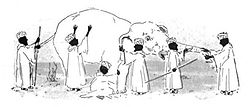This is an essay. It contains the advice or opinions of one or more Wikipedia contributors. This page is not an encyclopedia article, nor is it one of Wikipedia's policies or guidelines, as it has not been thoroughly vetted by the community. Some essays represent widespread norms; others only represent minority viewpoints. |
| This page in a nutshell: Reliable sources may be considered credible... until other reliable sources contradict them. |

Disputed loud and long,
Each in his own opinion
Exceeding stiff and strong,
Though each was partly in the right
And all were in the wrong.
The blind men and an elephant is a fable that originated in the Indian subcontinent from where it has widely diffused. It is a story of a group of blind men (or men in the dark) who touch an elephant to learn what it is like. Each one feels a different part, but only one part, such as the side or the tusk. They then compare notes and learn that they are in complete disagreement. Different observers of an event providing contradictory interpretations of the same event is also known as the Rashomon effect. The phrase is derived from the title of the Japanese film Rashomon (1950), where the accounts of the witnesses, suspects, and victims of a rape and murder are all different.
The blind men and the elephant story has been used to illustrate a range of truths and fallacies; broadly, the parable implies that one's subjective experience can be true, but that such experience is inherently limited by its failure to account for other truths or a totality of truth. At various times the parable has provided insight into the relativism, opaqueness or inexpressible nature of truth, the behaviour of experts in fields where there is a deficit or inaccessibility of information, the need for communication, and respect for different perspectives.
